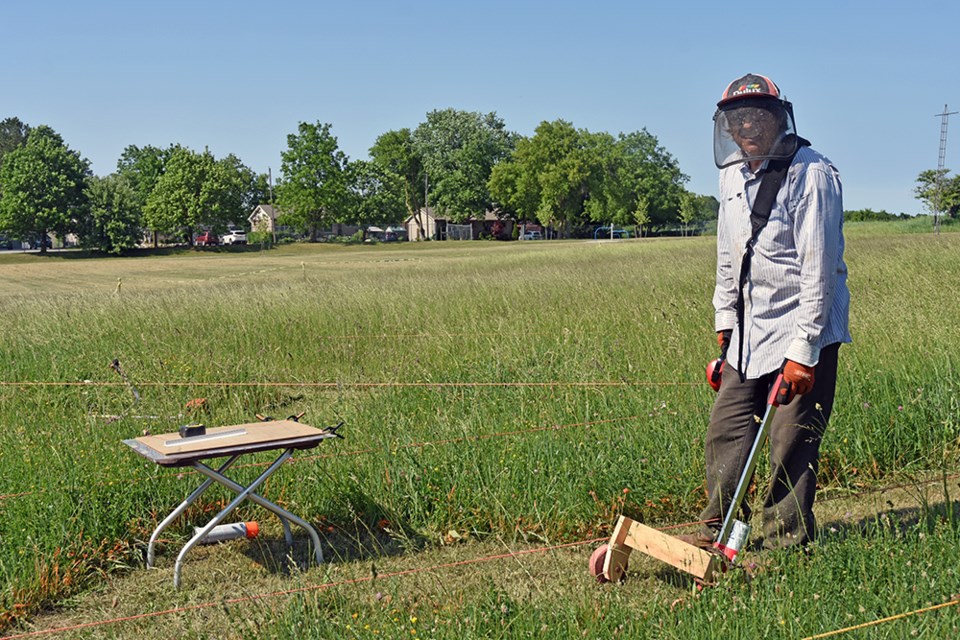Standing in a field just east of the Cookstown ideaLAB and Library, local artist Denis Bolohan swings a weed wacker, carving a path in the tall grass.
It’s not that Bolohan is engaged in yard work. He is creating a “living labyrinth” – an intricate pattern of interlocking pathways, carved into the grasses and wildflowers. Even as he works, under the hot June sun, bees and other pollinators continue to visit the clover and daisies that bloom in the untouched patches.
He calls the design, “The Tree of Life.”
Bolohan has a long association with labyrinths and mazes. He is known for his labyrinths carved on stone tablets, and for his “living” work, like the corn maze created at the Essa Agriplex, for the International Plowing Match in 2014.
But his connection to patterns, and symbols of the infinite, goes back even farther.
“It has to do with the work I was doing in the 1980s,” he explains – and even in the 1970s, when he began creating patterns, using Plexiglass and light.
While working on his Master's degree in Art, in the U.S., Bolohan says he was inspired by the reflection of candlelight on window panes – doubling and redoubling, as each reflection was reflected again.
“I started creating these infinity mirrors,” he says – using geometric shapes of Plexiglass to reflect light infinitely. It developed into installation art – immersive and interactive installations that invite viewers to enter into and become part of the artwork, where perceptions change with each step.
He began making ‘infinity cubes’ – six-sided mirrored cubes “so the images inside would go off, wherever you looked… infinitely” – and then full-sized installations, “where all the gallery walls would be covered with mirrors… You walked through the whole infinity.”
It was only when the cost of materials like metalized polyester became “prohibitive” that he gave up infinity installations – but not the idea of immersive art. Instead, he switched to living art installations.
His first was based on the layout of the Chartres Cathedral, and the Celtic cross – planting field corn and soybeans on his own 45-acre property, to create a walkable labryrinth, with an engraved stone mandala at its heart.
The new “environment that people walk through” made the news. “I had people coming in from all over the place,” Bolohan says.
Since then, he has been commissioned to create living labyrinths for a wide range of special events – including an Alumni exhibition at the University of Waterloo; a cornflower design for Dufferin County’s Corn Flower Festival, celebrating the 100th anniversary of Corn Flower Glass; and a design based on two interlocking hands for the Parliament of World Religions.
The designs are all inspired by the event and says Bolohan, “Every one of them, they are all original.”
Last week, he began work on the Cookstown labyrinth, commissioned by the Town of Innisfil and the Innisfil ideaLAB & Library. The work celebrates Innisfil’s Bicentennial, and the complex design is based on the Irish knot and Celtic Tree of Life – a nod to the Scottish and Irish settlers who first came to the region, and the “Celtic roots of the town,” he says.
“This was supposed to have been done last June, for the 2020 celebration,” Bolohan notes, but had to be deferred due to the COVID pandemic.
Covering a space measuring approximately 112’ by 130’ (34 x 40 metres), the living labyrinth required long hours of planning, not to mention the effort wielding the weed wacker, under the hot sun.
“We spent one and a half days just laying out the ropes,” Bolohan says, and protecting the area with police tape to prevent people from wandering through the partially-completed design. Work started June 8, and wrapped up more than a week later.
“It was more complicated than I thought,” he admits – although cutting a design in living grass is still easier and quicker than planting crops.
The labyrinth is “ephemeral art,” something that intrigues Bolohan: the image appears, engages and intrigues the viewer, and then ceases to exist, except in memory and in images.
The Tree of Life Bicentennial Labyrinth, adjacent to the Cookstown ideaLAB, will be open to the public on June 22, following the invitation-only official opening at 1 p.m.



